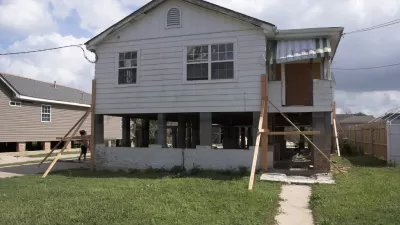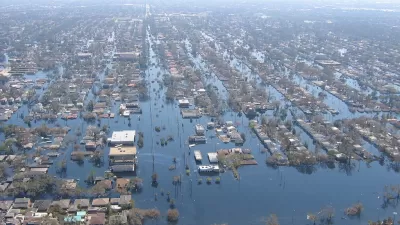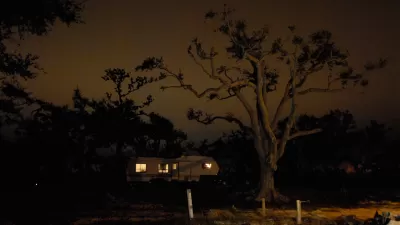Mark Byrnes explains the recent renovations - both inside and outside - of New Orleans' Superdome, home to Sunday's Super Bowl. The work was funded, at least in part, by FEMA.
The most recent images of the Superdome that many of us remember will include its use as an emergency shelter in the aftermath of Hurricane Katrina, when it became a temporary (and damaged) home to 20,000 refugees. In the years since, the building, which opened in 1975, has benefitted from more than $500 million in renovations, some of which might be noticeable in the eight hours of network television coverage this Sunday.
Perhaps the most interesting of the renovations are those that can be witnessed during the 355 days when the Saints aren't playing a game. "Perhaps the biggest change in the way people experience the stadium is through Champions Square, 60,000 square feet of new public space replacing a retail facility that struggled to come back after Katrina," explains Byrnes.
"New Orleans is built around a series of public squares," says Ellerbe Becket's Paul Griesemer, "so it was only natural we add on to that history."
"The square has also allowed the city to make the Superdome and everything around it lively when there’s no football game. Champions Square hosts concerts and local food vendors, creating a contemporary public space that fits in with the city’s traditional urban forms better than its retail predecessor. Planners hope to see a residential component added in the future. Says Griesemer: 'It’s really a story of great fortitude for everyone who wanted to bring the dome back and make sports the anchor of the city again.'"
FULL STORY: What Super Bowl Fans Can Expect From the Revamped Superdome

Planetizen Federal Action Tracker
A weekly monitor of how Trump’s orders and actions are impacting planners and planning in America.

Chicago’s Ghost Rails
Just beneath the surface of the modern city lie the remnants of its expansive early 20th-century streetcar system.

San Antonio and Austin are Fusing Into one Massive Megaregion
The region spanning the two central Texas cities is growing fast, posing challenges for local infrastructure and water supplies.

Since Zion's Shuttles Went Electric “The Smog is Gone”
Visitors to Zion National Park can enjoy the canyon via the nation’s first fully electric park shuttle system.

Trump Distributing DOT Safety Funds at 1/10 Rate of Biden
Funds for Safe Streets and other transportation safety and equity programs are being held up by administrative reviews and conflicts with the Trump administration’s priorities.

German Cities Subsidize Taxis for Women Amid Wave of Violence
Free or low-cost taxi rides can help women navigate cities more safely, but critics say the programs don't address the root causes of violence against women.
Urban Design for Planners 1: Software Tools
This six-course series explores essential urban design concepts using open source software and equips planners with the tools they need to participate fully in the urban design process.
Planning for Universal Design
Learn the tools for implementing Universal Design in planning regulations.
planning NEXT
Appalachian Highlands Housing Partners
Mpact (founded as Rail~Volution)
City of Camden Redevelopment Agency
City of Astoria
City of Portland
City of Laramie





























